Cardiology societies produce new bradycardia guideline
The American College of Cardiology, American Heart Association and Heart Rhythm Society on Nov. 6 released a new guideline for the evaluation and treatment of patients with bradycardia and cardiac conduction disorders.
The document, which is being co-published in journals associated with each society, outlines the clinical presentation of bradycardia and recommends approaches to evaluating those patients. Bradycardia is defined as a heartbeat of less than 50 beats per minute, according to an AHA release, and typically is broken up into sinus node dysfunction, atrioventricular block and conduction disorders.
Led by writing committee chair Fred M. Kusumoto, MD, the authors suggest preferred diagnostic tests and available therapies, including pharmacotherapy and external and implanted devices like pacemakers. They also highlight topics that require further investigation.
“Identifying patient populations who will benefit the most from emerging pacing technologies, such as His bundle pacing and transcatheter leadless pacing systems, will require further investigation as these modalities are incorporated into clinical practice,” said Kusumoto, a cardiologist at Mayo Clinic Florida in Jacksonville, in the release. “Regardless of technology, for the foreseeable future, pacing therapy requires implantation of a medical device, and future studies are warranted to focus on the long-term implications associated with lifelong therapy.”
The Journal of the American College of Cardiology produced a bradycardia guideline hub for its readers, complete with an outline, a slide set and the top 10 take-home points (with expert perspective) from the guideline. Check out the JACC hub here.

